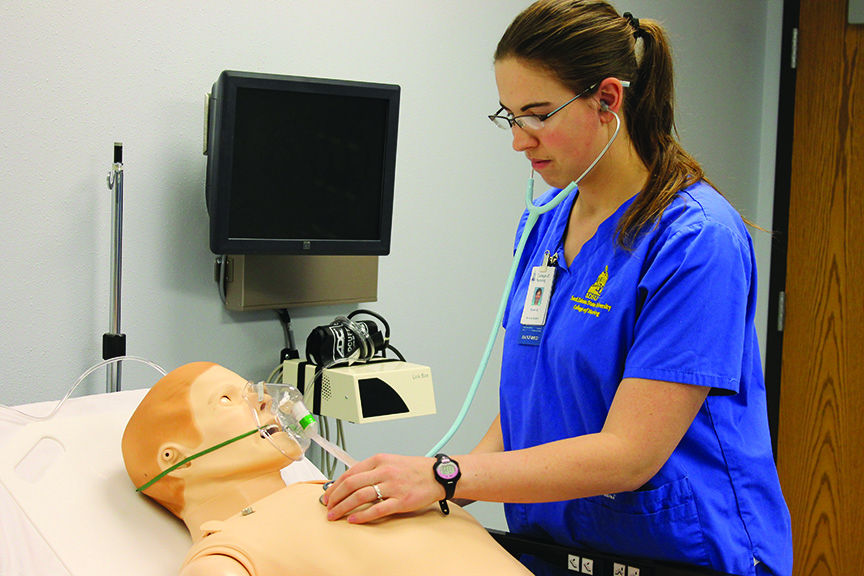Nursing dept. to open labs
January 28, 2015
After over a semester of construction, the College of Nursing’s newly expanded series of simulation labs are nearing completion and will be ready for nursing students to start using the labs’ hands-on experience capabilities within the next couple of months.
These new simulation labs, on the third floor of Wagner Hall, don’t introduce any new technology that wasn’t in the previous simulation labs, but the department felt that more labs were necessary for more out-of-hospital experience.
The new labs, which consist of four artificial patient rooms and two new control rooms, cost around $800,000, according to nursing simulation lab technician Aaron Tonsager.
“The difference [between the new and old labs] is the sheer size of the viewing windows to evaluate the students,” said Tonsager. “It’s more space so multiple classrooms could use it at the same time.”
The simulation labs are “invaluable” to the nursing department, according to Lois Tschetter, assistant academic dean of undergraduate nursing, because of the hands-on experience it offers to the undergraduate nursing students, who typically don’t have any experience as a nurse.
“This is a clinical learning environment for students, so we’re providing space that is very similar to the environment of a hospital room,” said Tschetter. “If students were to make an incorrect decision [here] they wouldn’t be putting an actual human in harms way.”
The labs are used four to five times a semester, and can continually aid nursing students who will make mistakes in simulation all the way from freshmen year up to their senior year.
“You almost always make a mistake in a simulation, and we’ll watch it back and discuss what we need to work on and what we did well,” said senior nursing student ambassador Mara Obbink. “I think all of the simulation experiences have enhanced my learning, so having more labs available is beneficial.”
Without a generous amount of room for mistakes in the nursing discipline, Tschetter explains how missing dosage in medication or missing an important allergy can be fatal mistakes in real world practice.
“[Students] could fail to recognize a trend in vital signs, such as increasing or falling blood pressure, and the student might not recognize that promptly enough to provide the appropriate intervention in the scenario,” said Tschetter. “…This simulation lab gives them confidence before they go to the hospital environment.”
While not only looking similar to a typical hospital room, the simulation labs also feature lifelike mannequins that can replicate many different symptoms of a human, including a speaker in the mouth and fluids that can come out of multiple spots on these learning tools that can cost up to $100,000; all of which is operated behind one-way glass in the control rooms.
“To be able to go through those processes with real equipment is great … There are an unlimited number of possible scenarios you could simulate,” said Tonsager. “The new SimLab control rooms’ windows stretch the entire width of the control room … so view from the control room into the lab is somewhat limited.”
The mannequins may seem to lack that human element at first, but with enough experience the nursing students treat them as they would any other patient.
“At first it feels awkward [to work with the mannequins] but they try to make it as real as they can,” said Obbink.
Many of the rooms simulate what a hospital scenario would be like, but there are different circumstances where nurses are needed, so the nursing department also added a different kind of simulation lab that doesn’t replicate a sterile, formal environment.
“We also added a room that can serve as a home environment, so students can practice visits in a home setting,” said Tschetter. “There’s also an exam room – similar to a doctor’s office clinical setting room so students have an opportunity to work in simulation scenarios in that clinical setting.”
Students typically don’t work alone, but instead work with a team of other students to tend to the symptomatic mannequins.
“I think it really helps with our delegation skills instead of one person – it’s more efficient,” said Obbink. “It helps with our critical thinking and on the spot skills that help us in the real world, where we really don’t get to stop and pause.”
On occasion when schedules align, the nursing department will work with other medical-related departments in simulation scenarios, which builds experience for not only students in other departments but also for the nursing students.
“For a couple of years we’ve been doing simulations with pharmacy students and then some with nutrition and dietetics students, so we’re looking to open up for opportunities with that interdisciplinary experience,” said Tschetter. “It’s limited only by our imagination and creativity.”
Having more simulation labs makes getting a nursing degree at SDSU more attractive to prospective students because it eliminates any need to travel to a different city for simulation lab, according to Tschetter.
“Students have learning experiences here without the cost or time to travel to Sioux Falls,” said Tschetter. “With an increasing number of nursing schools in the Sioux Falls region there’s more competition for clinical time in the hospitals, especially in specialty units such as Pediatrics or Maternity, so having the simulation lab gives students better time options instead of Saturday or Sunday hospital clinicals.”
According to both Tschetter and Tonsager, the construction of the new simulation labs during last semester wasn’t disruptive of the classes taught in Wagner.





















